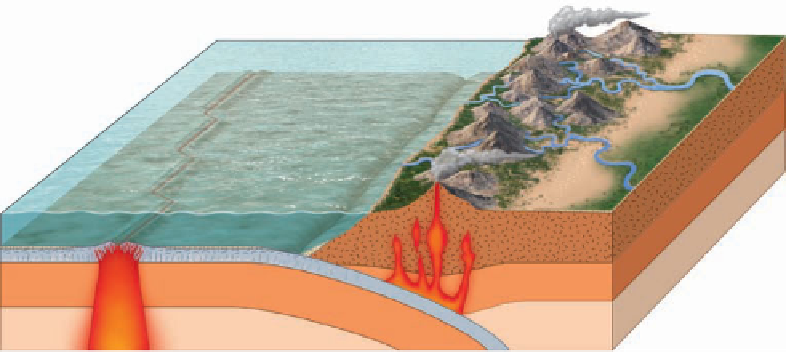Geology Reference
In-Depth Information
Plagioclase feldspars, which are nonferromagnesian
silicates, are the only minerals in the continuous branch of
Bowen's reaction series (Figure 4.4). Calcium-rich plagioclase
crystallizes fi rst. As the magma continues to cool, calcium-rich
plagioclase reacts with the melt, and plagioclase containing
proportionately more sodium crystallizes until all of the cal-
cium and sodium are used up. In many cases, cooling is too
rapid for a complete transformation from calcium-rich to
sodium-rich plagioclase to take place. Plagioclase forming un-
der these conditions is
zoned
, meaning that it has a calcium-
rich core surrounded by zones progressively richer in sodium.
As minerals crystallize simultaneously along the two
branches of Bowen's reaction series, iron and magnesium
are depleted because they are used in ferromagnesian sili-
cates, whereas calcium and sodium are used up in plagio-
clase feldspars. At this point, any leftover magma is enriched
in potassium, aluminum, and silicon, which combine to form
orthoclase (KAlSi
3
O
8
), a potassium feldspar, and if water pres-
sure is high, the sheet silicate muscovite forms. Any remaining
magma is enriched in silicon and oxygen (silica) and forms the
mineral quartz (SiO
2
). The crystallization of orthoclase and
quartz is not a true reaction series because they form indepen-
dently rather than by a reaction of orthoclase with the melt.
decreases the melting temperature beneath spreading ridges
because water aids thermal energy in breaking the chemical
bonds in minerals.
Magma formed beneath spreading ridges is invariably
mafi c (45-52% silica). However, the upper mantle rocks from
which this magma is derived are characterized as ultramafi c
(<45% silica), consisting mostly of ferromagnesian silicates
and lesser amounts of nonferromagnesian silicates. To explain
how mafi c magma originates from ultramafi c rock, geologists
propose that the magma forms from source rock that only
partially melts. This phenomenon of partial melting takes
place because not all of the minerals in rocks melt at the same
temperature.
Recall the sequence of minerals in Bowen's reaction
series (Figure 4.4). The order in which these minerals melt
is the opposite of their order of crystallization. Accordingly,
rocks made up of quartz, potassium feldspar, and sodium-
rich plagioclase begin melting at lower temperatures than
those composed of ferromagnesian silicates and the cal-
cic varieties of plagioclase. So when ultramafic rock starts
to melt, the minerals richest in silica melt fi rst, followed by
those containing less silica. Therefore, if melting is not com-
plete, mafi c magma containing proportionately more silica
than the source rock results.
One fundamental observation regarding the origin of magma
is that Earth's temperature increases with depth. Known as the
geothermal gradient
, this temperature increase averages about
25°C/km. Accordingly, rocks at depth are hot but remain solid
because their melting temperature rises with increasing pressure.
However, beneath spreading ridges, the temperature locally
exceeds the melting temperature, at least in part because pres-
sure decreases. That is, plate separation at ridges probably causes
a decrease in pressure on the already hot rocks at depth, thus
initiating melting (
Another fundamental observation regarding magma is that,
where an oceanic plate is subducted beneath either a conti-
nental plate or another oceanic plate, a belt of volcanoes and
plutons is found near the leading edge of the overriding plate
(Figure 4.5). It would seem, then, that subduction and the ori-
gin of magma must be related in some way, and indeed they
are. Furthermore, magma at these convergent plate boundaries
is mostly intermediate (53-65% silica) or felsic (>65% silica).
◗
Figure 4.5). In addition, the presence of water
Volcanoes
Continental
plate
Oceanic
trench
Pluton
Oceanic
crust
Upper
mantle
Continental crust
Upper mantle
Asthenosphere
Magma
Oceanic crust
Magma
Asthenosphere
◗
Figure 4.5
The Origin of Magma Magma forms beneath spreading ridges, because as plates
separate, pressure is reduced on the hot rocks and partial melting of the upper mantle begins.
Invariably, the magma formed is mafi c. Magma also forms at subduction zones where water from the
subducted plate causes partial melting of the upper mantle. This magma is also mafi c, but as it rises,
melting of the lower crust makes it more felsic.












Search WWH ::

Custom Search